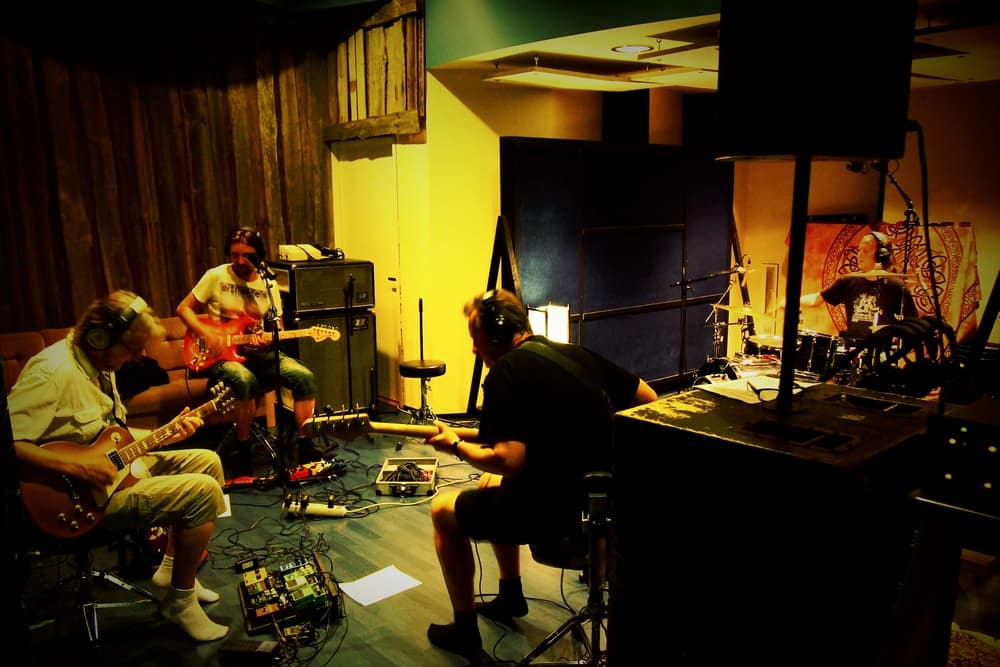Improve the sound of your band – 3 tips how to play solid and tight
Did you know that how tight you play affects the sound? The tighter you and your band play, the better your music sounds. Playing solid together is something that no editing can create. And such cheating that we call editing is revealed at the live show anyway, so why even bother? By reading this post you will improve the sound of your band – 3 tips how to play solid and tight.
Improve the sound of your band – 3 tips how to play solid and tight
Let’s continue with the theme from Isn’t Your Music Getting Reactions On Social Media And IRL? – 3 Tips To Make You Stand Out From The Masses blog post. These tips will help you stand out. Already during the 90’s I was known as a rhythm Nazi. Naturally the nickname has nothing to do with swastikas, but about my ability to spot tight playing or better yet, the lack of it. As a teenager I was drawn to albums where instruments locked-in and the playing was solid and tight. This is something I tend to bring to each session I record.
Sloppy playing is something that usually does not appeal to the masses so it’s important to continue reading. Let’s go through three highly important factors that will improve not only how tight you play but also how your band sounds.
1. Know your parts
This a bit lame sounding title is where we start off, but for a reason. No matter what I’ve been told, this obvious tip is surprisingly often neglected. Playing without full focus is not the same as rehearsing to the maximum. To know your parts and how to play them is essential. If this was properly done by every band and each member, giving birth to many albums would be a lot easier.
You should not go through your parts only with the band but also separately with each member. I explain this more thoroughly on Prepare For A Session blog post here. It is highly important to know not only what you but also what your bandmates play. Then again two guitars don’t necessarily have to play exactly the same patterns. Guns N’ Roses is a great example where two guitar players play completely different stuff and still it works great.
Instrument and vocal teachers have had their students march around while playing or singing. This is a great way to learn the basic pulse of the song and how your parts work. It’s surprisingly common that before entering the Anssi’s School of Music aka the first session at Astia, marching while playing is an impossible task. For some it’s like second nature, yet come 3-3-2 and confusion gets the better of the most. As strange and insignificant as it may sound, every musician should master the marching and the sooner the better.
Triplet or 3-3-2
It’s almost impossible to comprehend how common 3-3-2 rhythm is when it comes to riffs. Unfortunately it’s equally common that at least one member plays it as a triplet. The difference between the two is so important that you will now learn the how the angular triplet differs from a roundly grooving 3-3-2.
A triplet is a group of three notes that’s equal length to four straight notes. In English this means that while stomping four quarter notes with your foot, you play three notes, a triplet. This video shows you a simple way to understand a triplet. These three notes are of an equal distance from each other making them sound angular. Unlike many think, a triplet is not three consecutive notes played with random rhythm. I recommend you to watch this great video to learn how to play triplets. You must pay attention as the differences are small, yet highly important.
3-3-2 – also referred to as tresillo
This groovy and round 3-3-2 aka tresillo is the key to solid and tight playing no matter what style you play. Triplet sounds angular because each hit is equally long making the pattern constant and then again with 3-3-2 the three notes are divided into note length of 3, 3 and 2. You can count it with 8th notes like this: one-two-three one-two-three one-two. Let’s take a couple examples of 3-3-2 here and also here.
3-3-2 is easy to play just once, but can you keep it solid and tight for 5 minutes? You can do it when you are relaxed and completely focus on the groove. I constantly tap this on traffic lights to the beat of a turn signal relay. This rhythm is one of the keys to solid and tight playing so there might be a whole blog post dedicated to the awesome 3-3-2. It will help you evolve as a musician and improve the sound of your band.
Meshuggah and a kvartoli
Swedish metal band Meshuggah has taken this rhythm to a whole new level with kvartoli. It means to continuosly play four over three quarter notes. In a way it’s a flipped triplet where the triplet is the basic pulse and the basic pulse becomes the kvartoli. You can listen an example here and also here. First tattoo on my left arm was a kvartoli pattern. You can also spot it on nearly all Children Of Bodom songs that I’ve produced. The rhythm is pure awesomeness so I just couldn’t resist hiding it on their songs and the Bodom guys loved it as well.
If’ you are not familiar with Meshuggah‘s amazing Destroy Erase Improve album I highly recommend getting it as a CD or as a bit more rare vinyl record. Listening from streaming service is something I cannot recommend. Then again, can you spot a kvartoli pattern on a 1974 King Crimson’s classic album Starless And Bible Black 2nd song on the side A?
Read more: Vinyl Records And How To Improve Enjoying Music
2. Focus on your bandmates
It’s not that difficult to play fast technical patterns alone by the mirror or a laptop. “It sounded correct at home” is a bit too common phrase. So why playing solid and tight is more difficult in studio? Actually it wasn’t that good at the rehearsal place either. At home it might have been decent as the rhythm problems occur when you have to play in sync with others. This is something that anyone can and I think everyone definitely should learn. It will be a remarkable step on your path of becoming a skilled musician.
I’ve had several classical music virtuosos as a guest musician on sessions. Even though most of them are amazing when playing alone they find it difficult to play solid together with other instruments. No matter if you play in a band, only play at home or are a classical music virtuoso this noble art of how-to-listen-to-others cannot be over-emphasized.
Solid and tight together
Listening to others is an art on its own. First you have to know what you are playing and only then you can concentrate on others. There are a lot of similarities to downhill skiing. First it’s awesome to get all the way down without falling. Usually you mange to do this when looking at your feet. At some point you’ll lift your head up and all of a sudden see the beautiful view opening up in front of you. This is how you find a new outlook on things. Looking at your feet and by feet I mean fingers is a great way to practice. Yet, at some point you will wake up to the noise made by fellow musicians in an event that we professionals call a band rehearsal. Please do pay attention to what they are doing.
Few words about playing solid together. The name says it all; together. It would be great to play at the same time and to play even the same song. Once the song appears to be the same for each musician you can start putting your focus on how solid and strict you play together. All the way from the beginning until the end of song and every note in between must be solid and tight. Patience is a virtue in this department too. Yet, first you need to wake up to this to start improving.
How tight and accuratee should you play?
The accuracy of a quarter note is no task even for a beginner. Yet, it’s pretty common that to improve the accuracy several classes of Anssi’s school of music is needed. I am strict when it comes to the rhythm as it can either make or break a song. Tight and solid playing improves the sound itself and is pretty easy to spot.
Sometimes the bass player has gotten very frustrated as I’ve made him play the same part dozens of times. Some have even gotten angry at me as they haven’t noticed anything wrong with their playing. The point is that you are not playing any wrong notes. It’s that your instrument is not “locking-in” with other instruments. It’s not exactly the same to play with an 8th note accuracy compared to “locking-in” with others.
Once you “lock-in” you are accurate to a millisecond i.e. in perfect sync with other instruments. This is where you should aim, but what is this mysterious “locking-in” all about?
3. Lock-in thru being relaxed
When I mixed FOH for Children Of Bodom from 1998 until 2002 one item travelled with me all around the world; a book called Zen In The Art Of Archery. I’ve read it dozens of times and as a musician you should read it too. A brief browsing will leave you empty-handed. For a moderate reader the book, exactly like my blog posts, will give plenty. And once you replace the word archery with the instrument of your choice, you are onto something very cool.
Here’s the deal in a nutshell: practice until you you loose all interest. No try, only do. After years of repeating and practicing once you no longer “try”, something peculiar happens and in music it is called “locking-in”. This flow aka zone aka zen state of mind is what makes you play perfectly in sync with other instruments to a millisecond.
Many classic bands like Led Zeppelin, Cream and King Crimson were in a collective zen state of mind. If you have during a jam session with your band experienced a strange phenomenan where out of the blue you all do the same thing or movement at the same time I congratulate you. You have experienced zen!
How do I then get into this zen?
During hundreds of studio sessions I have noticed that being relaxed with an empty mind is the only way. The moment you realize you are in this state of mind, it has already ended. You shouldn’t pay any attention to it and then you can keep it going for quite long. My favorite drummer Mr Toni Paananen is a great example of such playing and you can notice it on several of his videos. He usually “slips into the zone” within the first quarter of the song as every move all of a sudden becomes smooth and beautiful. The look in the eyes also seems to change a bit. The playing gets relaxed and becomes in some ways perfect.
Famous Finnish musicians Mr Jarmo Nikku and Mr Masa Maijanen are great examples of this phenomenon. They can play with any drummer and immediately lock-in to the groove. I have witnessed an awesome moment when during live recording the drummer all of a sudden sways a lot and both Jarmo and Masa sway along to a millisecond.
The zen state of mind
These zen moments are something I always tend to wait for. Once the moment comes the parts are perfect. There’s a cool side-note that always happens in control room. Everyone in the room always wakes up from their mobilephones and shout out loud: “That was it!”. I’m certain everyone feels when that moment comes. This is what gives goosebumps and sometimes brings tears to the eyes of not only those present during the recording but also those who listen the music on full analog signal path.
This state of mind is where my aim has been for decades in both studio and when mixing live. This if not for the impatient as it takes time and dedication to master. Yet, in the end it’s all worth the effort and once you have experienced zen you know what all this is about!
Let’s recap my tips for more solid and tight playing
- Know your parts – and not only yours but also the parts of your bandmates
- Focus on your bandmates – learn the golden art of listening to others
- Read Zen In The Art Of Archery book – become your own zen master
3 tips how to play solid and tight
Thank you for reading my three tips for more solid and tight playing. From the bottom of my heart I hope they will help you and your band to improve. In these mp3-has-replaced-rehearsals times it’s a great way to stand out from the masses by physically spending time at the rehearsal room. Edited tightness is revealed latest at the live show so cheating in any form is something I do not recommend.
So many things around us is fake including the poor lipsync of the Trivago lady on the tv commercial to the music we listen and the food we eat. As the counter wave rises the real things are coming back not only with food and music, but in other departments too. Be genuine and rehearse to become better musician. Learn the technique and then “forget yourself”.
If this post was helpful, please share it on social media. This way you will help your friends to benefit from the information.
I cannot wait to reply your questions and comments so please do leave them below. Reserve a full analog tape recording session with me at Astia-studio by clicking here. Thank you very much and all the very best! Zen ?
Astia-studio is a full analog recording studio located in eastern Finland with 25 years of experience. Bands and artists from all over the world including USA and the furthest corner of Russia, Vladivostok have arrived to us for tape recording sessions.







04/07/2019 @ 4:20 pm
Täyttä rautaa!
04/07/2019 @ 4:27 pm
Kiitosten paljous, Tero. Perusasioiden äärelle on aina hyvä palata. ??